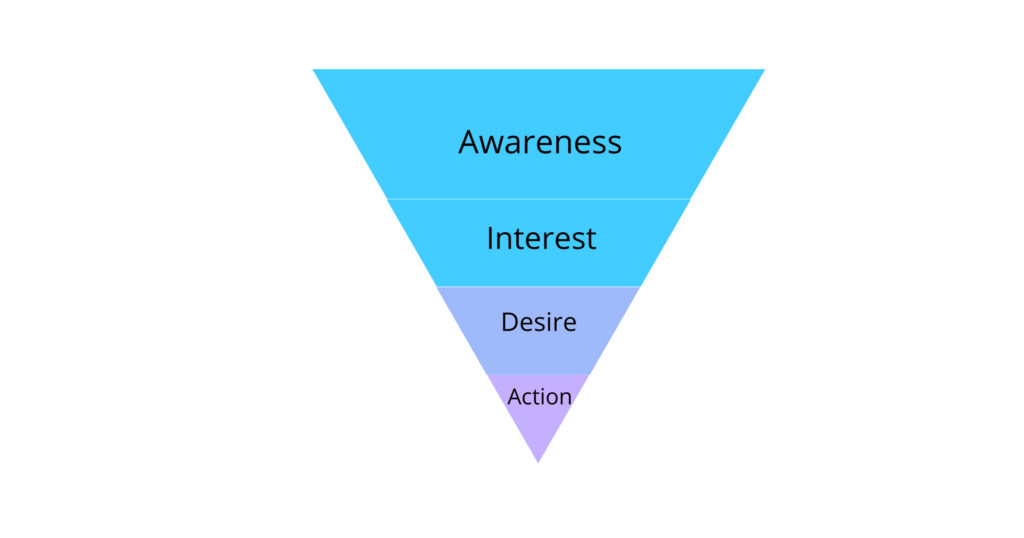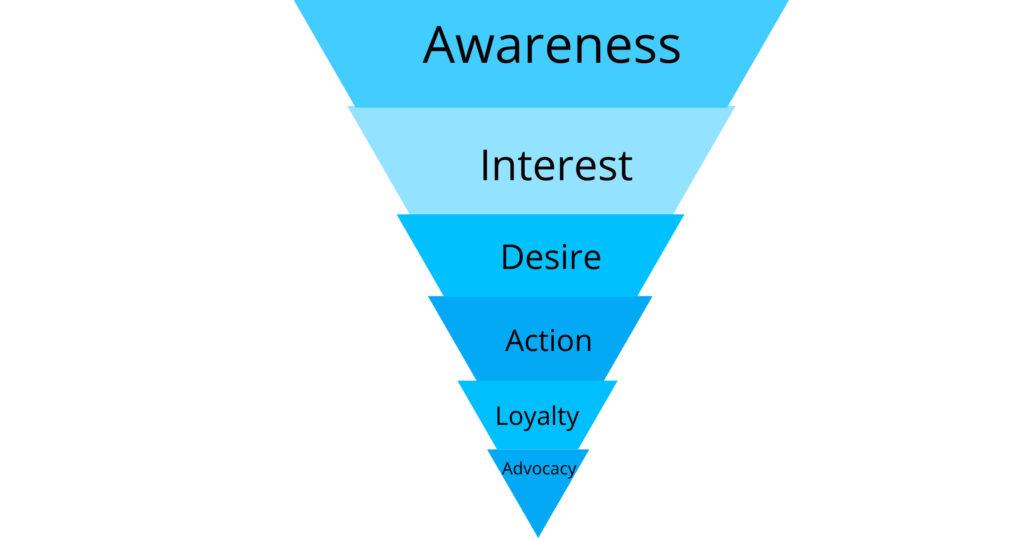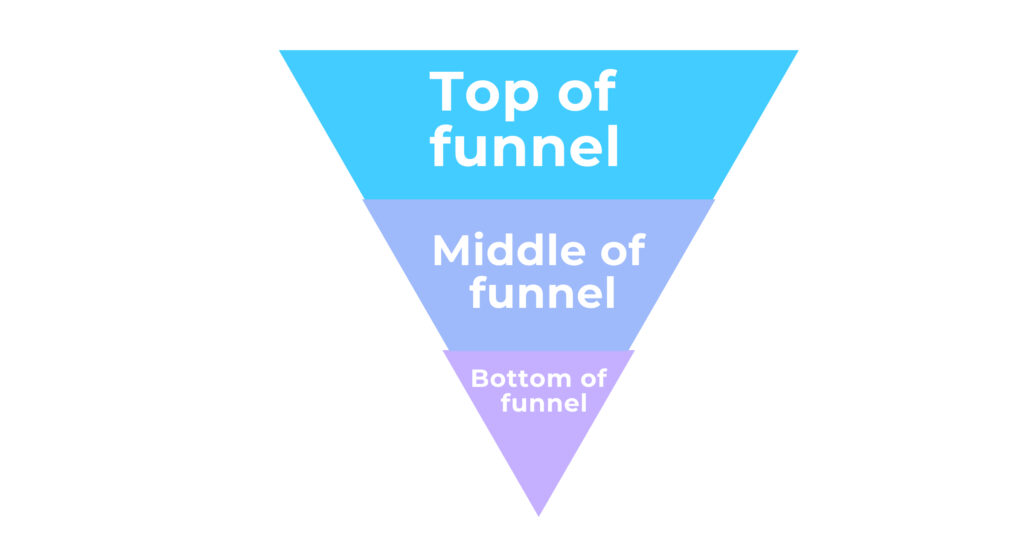The marketing funnel is an essential element of the marketing process. It outlines a user’s journey across campaigns and channels to convert from a prospect into a customer. The marketing funnel provides a framework for connecting and engaging with customers from the initial stage, when they have just learned about a business, to when they make a purchase, and even beyond.
Knowing how a marketing funnel works can help you understand what your company must do to influence consumers at every stage of the marketing journey to maximize results – drive more sales, greater loyalty, and stronger brand awareness. It can also help you diagnose problems and improve your overall marketing strategy.
In this guide, you’ll find everything you need to know about every marketing funnel stage and how to use it effectively for your business.
Evolution of the Marketing Funnel
The marketing funnel concept has been around for over a century and has since evolved from the traditional to the digital. The traditional marketing funnel is based on the AIDA model, which was first developed in 1898 by an American advertising and sales pioneer, E. St. Elmo Lewis.
This model highlights the stages of a customer’s relationship with a business, indicating that every purchase involves:
- Awareness stage: here, a prospect becomes aware of their problems and possible solutions, i.e., your brand, product, or service.
- Interest stage: here, the prospect shows interest in your brand, services, or products.
- Desire stage: here, the prospect evaluates your brand, product, or service.
- Action stage: here, the prospect decides whether to purchase and become a customer.

Some marketers say the AIDA model is incomplete because it focuses exclusively on converting a prospect into a customer. Therefore, to improve their marketing strategy, these marketers have added two more stages to the funnel:
- Loyalty stage: here, the customer repeatedly buys from you.
- Advocacy stage: here, the customer recommends your brand, product, or service to others.

However, some marketers prefer to keep their model simple by grouping the marketing funnel into three distinct elements:
- Top of the funnel (TOFU) – Awareness stage
- Middle of the funnel (MOFU) – Interest and Desire stage
- Bottom of the funnel (BOFU) – Action stage.

Today the marketing funnel is effectively used by marketers in different ways to archive their marketing goals,but all businesses universally accept no single model.
Marketing Funnel Definition
A marketing funnel is a graphical representation of a customer’s steps, from learning about your brand to becoming a customer. It is also known as the conversion funnel.
The marketing funnel shape corresponds to the idea that in the early stages of a purchasing journey, marketers cast a wide net to attract as many leads as possible before nurturing those leads through other stages of the funnel. As you move down the funnel, the audience narrows, and at the bottom, you have prospects who are most likely to buy and, ideally, become loyal customers.
Today the customer’s path to purchase is far more complex, and very few buyer’s journeys will follow the marketing funnel strictly. Successful marketing campaigns use a more comprehensive approach to reach shoppers at every stage.
Stages of the Marketing Funnel
Every stage of the marketing funnel needs to work very fine for the journey to be successful. With no single marketing funnel model universally accepted today, we’ll take a closer look at a six-stage marketing funnel and how to use it effectively.
Awareness stage
The Awareness stage is when a prospect learns and gets familiar with your brand.
Brand awareness always begins with consumer research and entails attracting customers to a brand and assisting them in recognizing and remembering it. The goal is to keep the brand at the forefront of the customer’s mind by incorporating relevant customer touch points along the path to purchase.
You want to put your brand in front of consumers wherever they are to increase awareness. It could happen in various ways
- Content marketing
- Digital advertising
- Social media campaigns
- Television (both linear and streaming)
- Audio advertisements, etc.
The goal of the awareness phase is for your brand to remain top of mind for prospective customers and make them remember you the next time they see your brand for future interactions.
Interest stage
The Interest stage is when a prospect expresses interest in your brand. It is an opportunity for brands to develop relationships with prospects and introduce their positioning.
Prospective customers get to the interest stage of the sales funnel because your content interests or entertains them. They want more of it because they have realized you have a possible solution to their problem. They want to learn more about your brand and what you do.
You must educate them more and prove that you are an expert or authority in the field or service you offer and that you are better than the competition. Typically, this interest manifests in them voluntarily doing the following
- Clicking on your ads
- Signing up for your email list.
- Subscribing to your YouTube channel.
- Following you on social media.
- Following your podcast on their favorite platform
- Registering for a webinar.
- They are filling and submitting your forms and providing you with their information.
The more interested they are in your brand, the more of these actions they take.
The goal of the interest stage is to develop a cordial relationship with prospective customers and inform them more about your brand, its products, and any helpful information and research it provides.
Desire stage
The desire stage, also known as the consideration stage, is when the prospects search for the best possible solution to their problem. The customer has developed a desire for your product or service; however, they might be considering two or more alternatives. Therefore, they will begin to assess your product or service’s worth, value, or quality.
Just because they know what you do and how you can assist them does not imply that you are their final option. Your marketing messages should address a consumer’s pain point, highlight an interest, or answer a question.
During the consideration phase, your prospects will read reviews, check alternatives, talk to friends and family, and compare which best fits them. You should educate and inform customers to help them understand how your services or product meets their needs.
You can make your most aggressive bid at this point. It could be
- A free trial
- A promotional code
- Positive customer reviews
- Customer testimonials
- Case studies
- A free product.
- A demo call
Make it so appealing that your lead can’t wait to use it.
At the end of consideration marketing, the goal is to increase the likelihood that consumers will consider your brand and its products when shopping by convincing them that you are the best.
Action stage
The Action stage is a relatively easy stage of the funnel. Now the prospect has decided to buy from you and use the solution you offer. At this stage, you are the chosen one, and the consumer buys your product or service and thus becomes a part of your company’s ecosystem.
Those who got to this stage believe in your brand, and they’ve chosen it as the right solution to their problem or meets their need. However, just because a consumer reaches this stage of the funnel does not mean your job is finished.
Therefore, use this stage as your brand’s opportunity to embrace a strategy that will help it stand out in its category and differentiate itself from peer products by delivering a quality product or service and providing a seamless purchase experience.
You want to do everything within your power to turn one purchase into as many purchases as possible by creating special offers and an exceptional customer service experience to grow the customer’s confidence in your brand.
Loyalty stage
The loyalty stage is when the customer repeatedly buys from you. Now you have converted a prospect into a customer whom you now have on board with your company. You must assist customers with all aspects and problems related to what they purchased from you to keep them happy, thereby ensuring that they remain interested in your product/service.
Positive interactions during and after the action stage can influence whether or not a customer becomes a repeat customer. Without a strategy for fostering customer loyalty, brands may discover that many customers make a single purchase and then abandon them. Aim to keep your customers satisfied and convert them into repeat customers and brand advocates.
Brands can stay top of mind for customers by following up and nurturing connections with them after they make a purchase. Therefore, continue engaging with customers who have invested in your brand’s products or services to build loyalty. According to invespcro, attracting a new customer costs five times more than keeping an existing one.
You can follow up and nurture connections with customers through special offers like
- Product usage guides
- Email nurture campaigns
- Surveys, outreach, and follow-ups
- Social media activations
- Technical assistance
- Regular discounts
Effective engagement marketing programs can have a significant impact on customer brand loyalty.
At the end of this stage, the goal is to earn loyal, satisfied customers who will become brand advocates and lifelong customers.
Advocacy stage
The advocacy stage is when the customer publicly supports or suggests your brand, product, or service to others. This stage is essential and effective for businesses to prioritize because it is cost-effective and high-yielding.
That you have sold to a customer and have them return through re-engagement at the loyalty stage does not mean the work is over. Have them advocate for your brand because they are a great source of information for leads and prospective customers.
Brand advocates contribute positive reviews and help boost brand awareness. According to Nielsen, 92% of consumers around the world say they trust earned media, such as recommendations from friends and family, above all other forms of advertising.
To maximize the benefits of this stage, you have to provide your customers with excellent products, services, and excellent experiences so that they cannot help but share them with others online – social mentions and reviews and in-person – Word of mouth.
Advocacy is very powerful, and no one can do it more effectively than a satisfied customer
The Benefits of Marketing Funnels
Marketing funnels offer a range of benefits to businesses, and they include
Helps Build Trust
A well-designed funnel can guide a prospect through each stage of the buying process, providing valuable information, addressing concerns, and answering questions. By educating and informing potential customers, you gain credibility and build trust with your target audience, which is crucial in today’s market, where consumers have access to a plethora of information and options.
Improves Marketing Strategy
A funnel helps you to understand your customer’s journey and the different stages they go through before purchasing better. This understanding allows you to create targeted marketing campaigns for each funnel stage.
It helps to identify where potential leads leave the funnel and resolve these issues to increase revenue
Creates Assets for the Sales Team
A marketing funnel helps provide valuable data about the loyal following of potential customers of every business. The sales team can then leverage these assets to close deals and convert leads into paying customers.
Simplifies the customer journey and makes it easier for companies to follow
Marketing funnels enable companies to create targeted marketing campaigns tailored to their potential customers’ needs and preferences. This allows businesses to identify which stage the customer is at and which marketing tactics will most effectively move them to the next stage.
Simplifies the measurement of KPIs
Marketing funnels can be a powerful tool for any business looking to streamline their customer journey and achieve better results in their marketing campaigns by simplifying the measurement of KPIs – lead acquisition, conversion rates, and customer lifetime value. The KPIs provide valuable insights for companies to optimize their marketing efforts and improve performance.
Tracking your customer’s behavior and actions at each funnel stage gives you valuable insights and data to optimize and improve your marketing strategies.
Brings visibility to every stage of connecting with your customer
At its core, a marketing funnel guides potential customers through each buying process step and converts them into paying customers. Businesses can create targeted messaging and content that speaks directly to their audience’s needs and interests by breaking down the customer journey into clear stages. This approach helps build trust and loyalty with your customers and ensures that every interaction with your brand feels personalized and relevant.
Increased customer lifetime value
By guiding prospects through each stage of the funnel and providing valuable content and offers, you can enhance customer loyalty and encourage repeat purchases. A well-designed funnel can also help you identify cross-selling and upselling opportunities, allowing you to increase the value of each customer over time. By focusing on the needs and interests of your customers, you can create a more tailored experience that builds trust and establishes your brand as a go-to resource for their needs.
Difference Between B2B and B2C Marketing Funnels
Marketing Funnels are highly effective when properly adjusted to suit your user personas. This is because the funnels often differ depending on your customer base. Although both funnels comprise the same stages, their customers’ behaviors differ.
B2B marketing funnels tend to be much more complex than B2C marketing funnels, as the B2B process typically involves multiple decision-makers and stakeholders. In contrast, in B2C, the consumer tends to move through the funnel alone. This makes the buying time for a B2B customer seem a little longer than a B2C customer.
B2C customers may never interact directly with a company representative but will make a purchase. However, the B2B customer may interact directly with sales representatives before making a purchase.
By understanding these differences between B2B and B2C marketing funnels, your business can leverage the appropriate funnel to maximize its marketing ROI.
Difference between the marketing funnel and sales funnel
The marketing and sales funnel are simply two parts of a whole. The marketing funnel helps form the marketing plan for a business. It is designed to attract and engage customers, while the sales funnel focuses on nurturing potential leads and converting them into paying customers.
The marketing funnel focuses on advertising a brand, product, or service to generate leads and give those leads a reason to buy. The sales funnel deals with these leads (from the marketing funnel) and tries to push them down the funnel to buy, not once, but as often as possible.
Marketing funnels offer a comprehensive view of the customer journey and the steps involved, from becoming aware of your brand, product, or service to purchasing and becoming a loyal customer. In contrast, the sales funnels are the step-by-step journey designed to guide each specific conversion event, such as opting in, signing up, or purchasing.
Note, Each is important in acquiring new customers.
Measuring funnel performance
As you build your funnel, you should assign metrics to each stage. The exact metric will depend on your channel or tactic. If you are looking for metrics to measure to check whether you are attracting your target market, here are the important marketing funnel KPIs at each stage.
Awareness stage – Post views, Ad clicks, and SEO rankings.
Interest stage – Number of new subscribers and followers, pricing page clicks, case study views, and the number of email list signups.
Consideration stage – Number of demos requested, free product or free trial signups, and click-through rate (CTR) for the email(s).
Action stage – Free Trial to Paid conversion rate, number of product or service purchasing made.
Loyalty stage – Net promoter score, customer satisfaction score, customer churn rate, and customer retention rate.
Advocacy stage – The loudest engagement, number of brand advocates, number of social shares, number of actions taken, and conversion rates.
One of the most important uses of the marketing funnel is to measure the effectiveness of the marketing strategies employed at each stage of the marketing funnel. By measuring the success of each marketing funnel stage, marketers can better understand their target audience’s behaviors and the effectiveness of each marketing campaign.
By measuring the performance of each strategy employed at each step of the funnel, it can be easier to determine if the funnel is successful or needs to be modified. If changes are needed, marketers can use this data to tweak the funnel accordingly and improve conversions.
By studying the data from successful marketing funnels, marketers can learn what works and what doesn’t, which can help increase the overall marketing campaign’s success.
Start measuring the right metrics today with any marketing funnel measurement tool of your choice. Compare these metrics month-on-month and take note of the differences made. If you notice an improvement, it means you are doing well and should press harder for better results. But if you see a decline in numbers, you have a problem and should experiment with other tactics to improve.
Evaluating and refining your funnel is a never-ending practice. But that’s the witty part of marketing. Continue experimenting, and you’ll discover ways to improve your results.
Final thoughts
A healthy business marketing funnel will have a good flow of people from the top all the way down to the action stage.
The marketing funnel is a tried-and-true method of guiding potential customers through the process of becoming paying customers. From awareness to decision to advocacy, the stages of the funnel provide a roadmap for businesses to follow in order to create effective marketing strategies.
By understanding the needs and behaviors of their target audience, businesses can create content and messaging that resonates at each stage of the funnel, ultimately leading to increased conversions and a stronger bottom line. By implementing a successful marketing funnel, businesses can connect with their target audience and grow their customer base over time.